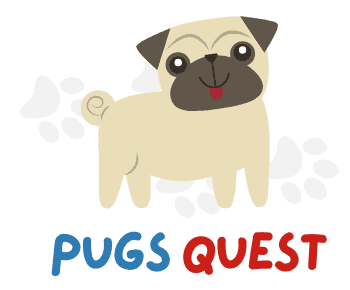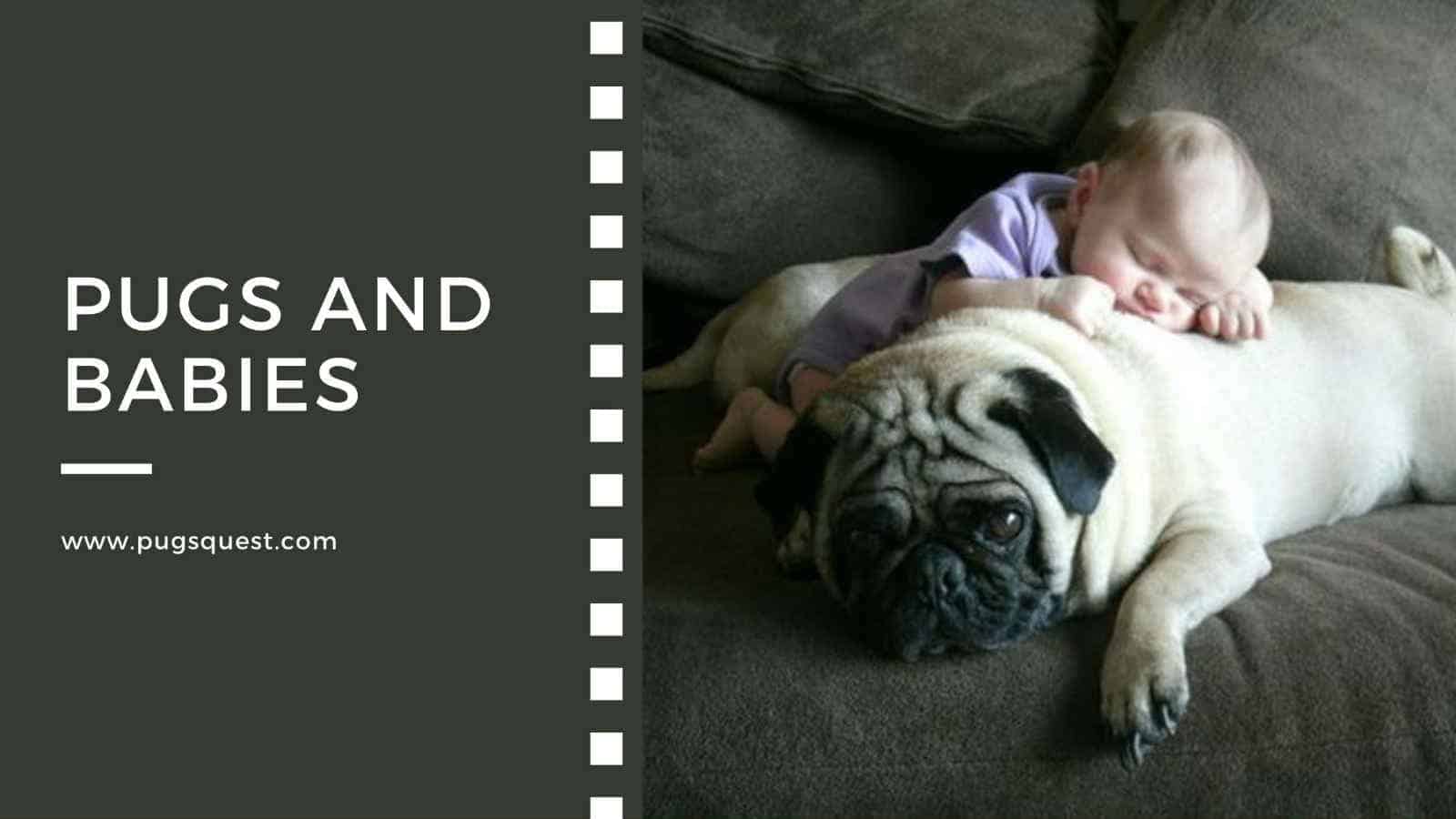Introducing dogs to children is nerve-wracking. If you’re thinking about introducing pugs to your kids and babies, we’ve got you.
We’ll cover
- Are Pugs good with babies and kids?
- Getting your Pugs ready for the baby and kids
- Troubleshooting tips for nervous Pugs
- and more
Let’s get started…
Are Pugs Good With Babies and Kids?
Pugs are great for families with babies and young children. A well trained, well-socialized Pug is a safe companion.
But, as with any animal, it’s important to remain vigilant.
Whatever you do, make sure your Pug is properly trained before introducing them to a child.
1. What Makes Pugs Good Around Babies and Kids?
- Pugs are loyal
This breed is about as loyal as it gets. They’re called velcro dogs for a reason. They like to stay by their family’s side, offering a lot of love, fun, and constant affection. Expect a pug at your feet wherever you go.
Your child will have a constant companion. These goofy dogs are the ultimate entertainers and, often, pugs and children become best friends. A Pug’s loyalty means they’re always looking out for you and trying to keep you safe.
- Pugs are passive and tolerant
Aside from the occasional burst of energy, Pugs are a generally passive breed. They love to cuddle and pose very little danger to young children.
They are docile and tolerant of new people meaning Pugs and babies can be introduced early on.
- Pugs are quiet
Pugs bark very little in comparison to other breeds and are unlikely to startle young children. They tend to bark only when warning their family of perceived threats, making them devoted watchdogs.
- Pugs are easy to train
Pugs are easy to train and socialize, especially whilst they are still young. Get training started as early as possible.
Pugs are adaptive learners. That means they rarely repeat the same mistake twice. Great quality with kids around.
2. Risk Factors You Need To Know
Even though Pugs are widely considered to be kid-friendly, it’s important that owners educate themselves about the potential risk factors.
Pugs are live animals with emotions and behavioral quirks. Pugs love to jump which could potentially scare a young child. But don’t worry. We’re going to tell you what to look out for.
- Pugs are stubborn
Pugs can develop a learning curve once they’ve passed their adolescent years. They often become less responsive to new commands.
That’s why it’s important to get essential training done early. If your pet is going to be around children, make sure they are socialized with babies from a young age.
- Snoring
As Brachycephalic dogs, Pugs’ are heavy snorers. They may not bark, but they can be noisy whilst they get those zees.
This might not be ideal with a newborn baby around or for any light-sleepers in the family.
Getting Your Pugs Ready for The Baby
Introducing any dog to a newborn baby is daunting. We’ve prepared a step by step guide on how to introduce Pugs to your babies.
1. Before the Baby Arrives
Many dogs will sense something is up when their family starts preparing for the new arrival. Most expectant parents start rearranging their home in preparation. Be aware that this can be confusing for your Pug.
- Be patient with your pet
Start gradually introducing your Pug to life’s new sounds and smells in advance. That could mean playing baby sounds in the house or letting them smell baby lotion.
- Introduce baby room to Pugs in advance
If you plan to allow your Pug into the child’s room, encourage your pug to explore the space in advance and start enforcing any rules early (no jumping on the crib).
- Invest in a safety gate
Some parents prefer to keep animals out of the nursery all together. In this case, safety gates and screens are a great option. Your Pug will be able to see what’s going on without entering the room. This will help them feel involved and prevent feelings of isolation or jealousy.
2. Create a New Normal
Things are going to change around the home. You’ll have less time to devote to your pet. It’s important to get your Pug used to this new dynamic before the baby arrives.
- Start adjusting your pet’s daily routine early.
- Prioritize smaller chunks of quality time with your pet.
- Get your Pug used to walking alongside a baby stroller using a baby doll as a substitute.
- Enforce the rules. That means no licking and no jumping.
3. Get a doggy sitter
With a child in your life, you won’t be around to look after your Pug 24/7. It’s important to make arrangements, starting with the delivery.
- Who’s going to look after your pooch when you’re delivering the baby?
- Who’s going to pick up the slack whilst you’re getting to grips with a newborn?
It’s time to call in the troops and get friends and family to step in.
By making sure your dog still gets plenty of human attention. Their old routine mustn’t be completely upended.
While the baby is sleeping, make time for your pet to show them you care. Plus, your Pug’s love and kindness are bound to give you a boost as well.
4. Introducing Pug and Baby
There are some final steps you can take to make the transition as smooth as possible.
Before bringing your baby home, try to introduce their scent. A baby blanket is ideal. Let your Pug smell and investigate the blanket.
On the day of arrival, ask somebody else to carry the baby inside. This way you can greet your Pug calmly and give them some much-needed attention.
Once you’ve settled in, let your Pug approach you and baby. If your Pug seems nervous or overexcited, remove yourself and the baby from the room and let your dog calm down.
Maintain a positive attitude around your pet. Try to keep rules and routines as normal as possible.
If your pug used to be allowed on the couch, continue to let them on the couch and be affirming when your Pug approaches the baby.
Remain calm and resist unnecessarily disciplining your pug as they investigate – even if you’re feeling nervous.
If you’d prefer to keep your dog in a crate whilst your newborn settles in, make sure you establish this new routine well before the due date. Do not lock your pet away every time the baby is around as this can be extremely traumatic for your Pug.
5. Be vigilant and supervise
Be vigilant each time Pugs and babies are together. Animals and babies are unpredictable. Your baby could easily startle your Pug and vice versa. Pugs are a docile breed and unlikely to attack a baby, but it’s important to monitor behavior nonetheless.
Once your baby is mobile, start teaching them boundaries. Keep them away from your Pug’s toys, food bowls, and litter trays (this is potentially toxic). The safest option is to keep these areas off-limits by installing child safety gates.
Troubleshooting: If Your Pug Is a Little Nervous About the Baby and Kids
If you find your Pugs to be nervous around children at first, here are some actionable steps you can take to troubleshoot those nerves away.
1. What to do about a nervous Pug
If your Pug shows signs of nervousness around your child, remain vigilant, and take some safety precautions. Here are some top tips and tricks.
Don’t
- Force your dog to interact with your child
- Let your child manhandle your dog. Don’t let them kick, pinch, ride, tease, or scare your Pug.
Do
- Let your Pug approach your child on their own
- Teach your child to respect your dog. Show them what appropriate, gentle play looks like.
- Offer your Pug positive reinforcement. For example, let your Pug approach the baby’s high chair to enjoy all the leftover food that falls from the table. Your Pug will start to see that having a baby around isn’t so bad after all.
- Take your pooch to obedience classes along with your child. This will teach the child how to interact appropriately with your Pug and give consistent commands.
2. What to do about an aggressive Pug
Signs of aggression always cause concern. But it’s even more important to nip these behaviors in the bud when a child is around.
Your Pug might show signs of aggression if they’ve not been well socialized around children or feel possessive over their food and toys.
We want to avoid the worst and introduce dogs and babies safely. Here are some top tips.
Don’t
- Let your child play with your Pug’s personal possessions
- Verbally or physically punish your dog for signs of aggression. Why? Because this is your pug’s warning system. Without this, you won’t know when they are feeling threatened. Additionally, by punishing a nervous dog, you’ll only reinforce their negative associations with your child.
Do
- Teach your child to respect your Pug’s boundaries and leave their things alone
- Teach your child to recognize your Pug’s warning signs (growling or barking)
- Keep your child away from an aggressive dog
- Seek the help of a dog behaviorist with experience training aggressive dogs
Top tip: Make sure you’re calling on a Certified Applied Animal Behaviorist (CAAB), a board-certified veterinary behaviorist (Dip ACVB), or a Certified Professional Dog Trainer (CPDT-KA).
FAQ
1. Are pugs good with kids?
Yes, Pugs make great family pets. Children and Pugs often become great companions.
Pugs are loving, loyal, and playful. They are also robust enough to deal with some rough and tumble.
If you’re looking for a doggy companion for your child, a Pug is the way to go. Your kid will benefit from the responsibility and affection that comes with caring for a pet.
2. Are pugs good with children?
Sure, Pugs are a good breed to match with very young children. They are friendly, quiet dogs and will look out for the children of their family above anything else.
Pugs and Kids/Babies: Are They Compatible?
If you’ve got a young baby or are expecting the pitter-patter of tiny feet, a Pug is the pet for you.
Though all dogs are different, pugs and kids/babies tend to get along just fine. Bred as companion lapdogs, a Pug has the potential to become your child’s new best buddy.
Once you’ve decided to introduce a pug to your child, put in the groundwork. This will make the transition as smooth as possible.
Remember to look out for warning signs. If your Pug is nervous, remain calm and take the actionable steps required.

